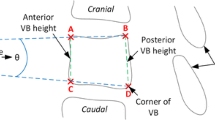Abstract
Study design
This is a cross-sectional descriptive study objectives to describe normal development of thoracic vertebrae during childhood and document contribution of individual vertebral shape to the sagittal alignment.
Summary of Background Data
Sagittal spinal alignment changes during growth. The changes in sagittal alignment during adolescent growth spurt as well as the individual shapes of thoracic vertebrae have been implicated as factors for the development of adolescent idiopathic scoliosis (AIS). The contribution of individual vertebral shape to the sagittal alignment and the changes in the vertebral shape with growth is not known.
Methods
Sagittal computed tomographic (CT) scans of thoracic vertebrae were examined in children without any evidence of spinal deformity. Vertical distances between the endplates at the most anterior and most posterior sides of vertebral body were measured as anterior vertebral height (aVH) and posterior vertebral height (pVH), respectively.
Results
There were a total of 133 CT scans done on 71 male and 62 female children. The children were grouped as follows: Group I (0–2 years of age), Group II (3–6 years of age), Group III (7–9 years of age), Group IV (10–12 years of age), and Group V (13–16 years of age). A-P ratios of vertebral heights were grouped as T1–T5, T6–T8, and T9–T12. Measurements demonstrated that the anterior and posterior heights in each vertebra grew longitudinally and consistently with increasing age. The aVH/pVH ratio of each individual vertebra showed no significant difference according to age. Measurements of thoracic vertebrae on sagittal spinal CT images did not show any differences in the relative growth and heights of the anterior versus posterior walls of the vertebral bodies in any of the segments in any age or age group.
Conclusions
The sagittal alignment changes during growth are likely related to maintenance of sagittal balance rather than the shapes of individual vertebrae.
Level of Evidence
Level II
Similar content being viewed by others
References
Cil A, Yazici M, Uzumcugil A, et al. The evolution of sagittal segmental alignment of the spine during childhood. Spine 2005;30:93–100.
Willner S, Johnson B. Thoracic kyphosis and lumbar lordosis during the growth period in children. Acta Paediatr Scand 1983;72:873–8.
Dickson RA, Lawton JO, Archer IA, et al. The pathogenesis of idiopathic scoliosis. Biplanar spinal asymmetry. J Bone Joint Surg Br 1984;66:8–15.
Roth M. Idiopathic scoliosis caused by a short spinal cord. Acta Radiol Diagn 1968;7:257–71.
Dubousset J, Herring JA, Shufflebarger H. The crankshaft phenomenon. J Pediatr Orthop 1989;9:541–50.
Somerville EW. Rotational lordosis: the development of single curve. J Bone Joint Surg Br 1952;34–B:421–7.
Liljenqvist UR, Allkemper T, Hackenberg L, et al. Analysis of vertebral morphology in idiopathic scoliosis with use of magnetic resonance imaging and multiplanar reconstruction. J Bone Joint Surg Am 2002;84:359–68.
Liljenqvist UR, Link TM, Halm HF. Morphometric analysis of thoracic and lumbar vertebrae in idiopathic scoliosis. Spine 2000;25:1247–53.
Millner PA, Dickson RA. Idiopathic scoliosis: biomechanics and biology. Eur Spine J 1996;5:362–73.
Roth M. Idiopathic scoliosis and Scheuermann’s disease: essentially identical manifestations of neuro-vertebral growth disproportion. Radiol Diagn 1981;22:380–91.
Guo X, Chau WW, Chan YL, et al. Relative anterior spinal overgrowth in adolescent idiopathic scoliosis. Results of disproportionate endochondral-membranous bone growth. J Bone Joint Surg Br 2003;85:1026–31.
Zhu F, Qiu Y, Yeung HY, et al. Histomorphometric study of the spinal growth plates in idiopathic scoliosis and congenital scoliosis. Pediatr Int 2006;48:591–8.
Schlosser TP, van Stralen M, Brink RC, et al. Three-dimensional characterization of torsion and asymmetry of the intervertebral discs versus vertebral bodies in adolescent idiopathic scoliosis. Spine (Phila Pa 1976) 2014;39:E1159–66.
Schlosser TP, Vincken KL, Rogers K, et al. Natural sagittal spinopelvic alignment in boys and girls before, at and after the adolescent growth spurt. Eur Spine J 2015;24:1158–67.
Author information
Authors and Affiliations
Corresponding author
Additional information
Author disclosures: OD (none); KB (none); HGD (none); EA (none); MY (none).
Rights and permissions
About this article
Cite this article
Dede, O., Büyükdogan, K., Demirkıran, H.G. et al. The Development of Thoracic Vertebral Sagittal Morphology During Childhood. Spine Deform 4, 391–394 (2016). https://doi.org/10.1016/j.jspd.2016.08.001
Received:
Revised:
Accepted:
Published:
Issue Date:
DOI: https://doi.org/10.1016/j.jspd.2016.08.001




